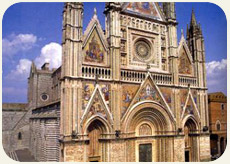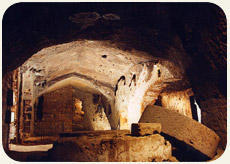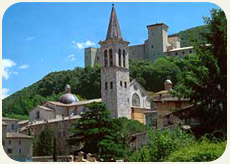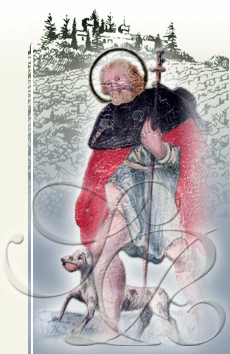| Orvieto
and Spoleto, medieval tourist towns in Umbria... |
| |
|
| Orvieto, 30 kms far from Farmhouse San
Rocco.... |
| |
|
Orvieto origins go back to the Etruscan
civilization: the
first Etruscan settlements, going back to the 9th Century
B.C., infact, were found inside the tufaceous caves in the
bedrock upon which today rises the city.
Annexed in the 3rd Century B.C. to the territories of Rome,
it remained under the Roman domination until the decline
of the Western Roman Empire. Afterwhich it became a free
municipality, and during the struggles between Guelphs and
Ghibellines, was a valiant opponent of Barbarossa, remaining
faithful to the Pope.
|
| |

 |
Riding on the support of the Papal
State, it was allowed to prosper through the entire Medieval
Period, reaching the top of its development in the 13th Century
with the constitution of the General Council of the 400 and
the election of the Captain of the People.
It was during this period that one saw the fervent work
of erecting palaces and holy buildings among which the very
famous Cathedral stands out, dating back to 1263, undoubtedly
the most important architectural landmark of the city, with
its splendid Gothic facing and the richness of the ornaments
and internal chapels. In the ancient town we also find the
St.Patrizio well, built in 1527 based on a plan of Antonio
da Sangallo il Giovane, the Palace
of the Seven from 1300,
the Palace of People Captain (12th Century) inside which
took place the meetings of the People's
Council, Saint Andrew’s
Church (12th Century), Saint
Domenic’s Church (12th
Century), Saint Giovenale’s Church (11th Century),
Soliano Palace (1262) within which, one will find two museums:
the Museum of the Opera del Duomo and the Museum
of Modern Art. Moreover we remember the Mancinelli Theatre (1866),
the suggestive Underground City and the Necropolis of the
Crucifix of Tufo dating back to the Etruscan period.
|
| |
| Spoleto, a 35 Kms from Agriturismo
San Rocco |
| |
|
Spoleto, even if shows evident traces of the Roman era even
in its urban structure, substantially mantains a medieval
appearance, due to the period in which it was first a flourishing
longobard Duchy, and then an important city within the Papal
State.
The Arch of Drusus (23 A.C.)
to be found near the Romanic church
of St. Ansano , the Roman theater,
whose construction goes back to the first years of the Empire,
and the paleocristian basilica St. Salvatore of the 4th century
(at about 1.2 km's distance to the north), are testimonials
of Spoleto's earliest origins.
|
| |
|
Close by, the church St.Gregorio
Maggiore (12th
century), characterized by its evocative apsis zone and by
the elevated presbitery, a Roman bridge (also called "the
Bloody") consisting of three arches in travertine stone
blocks and the amphitheater of the 2nd century A.C. can be
found. More modern monuments which are as fascinating are
the churches of St. Dominic and St.
Ponziano, both of which
were built during the 12th century. The church of St. Peter
is surely of great interest because of its extraordinary
bas-reliefs which decorate the facade which dates back to
the 12th century.
From the area found in front of the
church of St. Peter one enjoys a wide panorama which encompasses
all of Spoleto until the mighty Bridge
of the Towers (ten
arches with a total height of 80 meters and 230 meters long),
which connects the Castle, which was constructed from 1352
onwards on the orders of the Cardinal Egidio Albornoz according
to plans by Matteo Gattaponi, to the runners of the mountain
which dominates the city. Monteluco was, in fact, the sacred
mountain of the anchorites, who having settled in this zone
from the 7th century on, founded the convent of St. Francesco,
to be found at about 8 km's distance from the inhabited area,
and the church of St. Julian.
|

 |
| |
|
Without doubt, on the person who has the good luck of visiting
these sights, the entire Cathedral complex constructed during
the 12th century and caracterized apart from the richness
of furnishings of the interior also by the mosaics in the
Byzantine style on its facade, and the Romanic church of
St.Eufemia will make an unforgettable impression.
Among the most important manifestations
taking place in the city we should absolutely mention the Festival of the two Worlds.
|
|
 |
|

